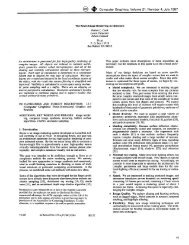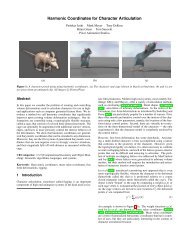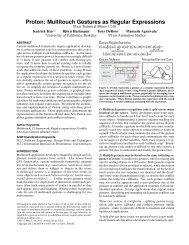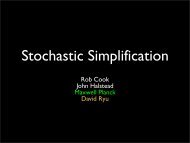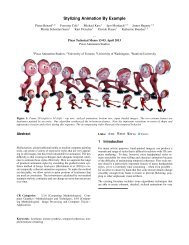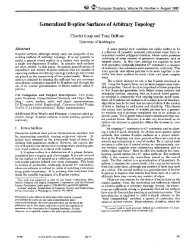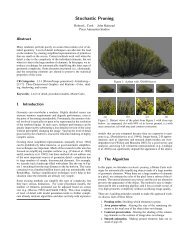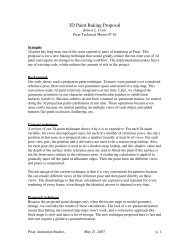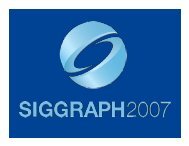Artistic Simulation of Curly Hair - Pixar Graphics Technologies
Artistic Simulation of Curly Hair - Pixar Graphics Technologies
Artistic Simulation of Curly Hair - Pixar Graphics Technologies
You also want an ePaper? Increase the reach of your titles
YUMPU automatically turns print PDFs into web optimized ePapers that Google loves.
p'2d 1d 2dd43p'p'p'd 0p'5p1e 1p12p354e 0e e 42ep0p3p3 4Elastic rods model (E = G = 8 × 10 9 )Figure 3: Original curve (bold line) with points p i and edges e ioverlaid with corresponding smoothed curve (thin blue line) withpoints p ′ i and edges defined by vectors d i.Our bending model (k b = 3 × 10 4 , c b = 1.74 × 10 3 )Figure 2: Simple example <strong>of</strong> a perfect helical curl undergoingmotion from the walk cycle <strong>of</strong> Figure 12. The elastic rod model (top)introduces rotation around the helix, apparent in the orientation <strong>of</strong>the end <strong>of</strong> the curl, while our bending model (bottom) does not.<strong>of</strong> curls (Section 3.3). These three springs comprise our per hairforce model.3.1 Stretch SpringWe define our hair model using a set <strong>of</strong> particle positions connectedby linear springs. Let each hair be defined by a set <strong>of</strong> current particlepositions P = {p 0, . . . , p N−1} and initial rest pose particles,¯P , where ¯· denotes rest quantities. Let the current velocities forthese particles be V = {v 0, . . . , v N−1} and the polyline edgesconnecting hair particles be e i = p i+1 − p i. We compute a standarddamped linear spring force on particle i byf s(k s, c s) i = k s(‖ e i ‖ − ‖ ē i ‖)ê i + c s(∆v i · ê i)ê i (1)where k s are the spring and c s the damping coefficients, ∆v i =v i+1 − v i, ‖ · ‖ denotes vector length and ˆ· vector normalization.Because springs in our model are connecting two particles, each<strong>of</strong> our spring forces is applied equally to both particles in oppositedirections.Our artists also want to enable bounce during a walk cycle, for example,by allowing hair to slightly stretch (see Figure 12 and thevideo for an example). To allow this artistic stretch <strong>of</strong> the hair withoutusing stiff springs, we impose an upper limit on the stretch <strong>of</strong>the polyline similar to the biased strain limiting approach presentedin [Selle et al. 2008]. During the spring damping calculation, werecurse from the root to the tip limiting the velocity <strong>of</strong> the hair particleif ∆vi2 exceeds a threshold. After we update positions, weagain recurse from the root <strong>of</strong> the hair to the tip shortening edgesthat exceed the specified stretch allowance. By using this limiter,artists are able to control the desired amount <strong>of</strong> stretch allowed bythe system.3.2 Bending SpringOur method to control bending is most similar to the elastic rodsmodel [Bergou et al. 2008; Bergou et al. 2010], which computesthe material frame as the minimizer <strong>of</strong> elastic energy <strong>of</strong> the curve.They use these material frames to compute the bending and twistingenergies along the rod. However, the formulation <strong>of</strong> Bergou et al.introduces rotation during simple motion <strong>of</strong> a curl, such as a walkcycle, shown in Figure 2 top. This rotation can be removed by! = 0 ! = 2 ! = 4 ! = 6 ! =∞Figure 4: Example <strong>of</strong> a stylized curly hair (far left) and thesmoothed curves (blue) computed with α at 2, 4, 6, and ∞.increasing the material’s stiffnesses, but this change leads to wirelikebehavior (see video).This type <strong>of</strong> rotation in the curl, while physically accurate, is undesirablefor our application. Our hair model instead introducesa method to stably generate the material frame by parallel transportingthe root frame <strong>of</strong> the hair along a smoothed piecewise linearcurve (see Section 3.2.1). The result <strong>of</strong> using our smoothedcurve is a series <strong>of</strong> frames that are not highly influenced by smallchanges in point positions, avoiding unwanted rotation as illustratedby Figure 2 bottom. Our bending formulation uses reference vectorsposed in the frames from the smoothed curve to compute thebending force (see Section 3.2.2).3.2.1 Smoothing FunctionLet Λ = {λ 0, . . . , λ N−1} be a set <strong>of</strong> N elements in R 3 associatedwith a hair, such as particle positions or velocities. We define oursmoothing function, d i = ς(Λ, α) i, with an infinite impulse response(IIR) Bessel filter (for examples, see [Najim 2006]). Thesefilters are recursive functions, combining the input and prior resultsto produce each new result.To compute the results, we take as input the smoothing amount,α ≥ 0, in units <strong>of</strong> length along the curve. Let β = min(1, 1 −exp(−l/α)) where l is the average rest length per segment <strong>of</strong> thehair being smoothed. We then recursively compute vectors d i ∀i ∈[0 . . . N − 2] with the equationd i = 2(1 − β)d i−1 − (1 − β) 2 d i−2 + β 2 (λ i+1 − λ i) . (2)By choosing these coefficients and initializing d −2 = d −1 = λ 1 −λ 0, this equation reduces to d 0 = λ 1 − λ 0 at i = 0. Subsequentd i values are weighted towards this initial direction, an importantproperty for our usage <strong>of</strong> this function.When Λ is a set <strong>of</strong> positions, we can reconstruct the smoothed polylineby recursively adding the vectors from the fixed root position.The new points, p ′ i ∀i ∈ [1 . . . N − 1], are defined byp ′ i = p ′ i−1 + d i−1 (3)where p ′ 0 = λ 0, the root <strong>of</strong> the polyline. We show the relationshipbetween an original and smoothed curve in Figure 3.



